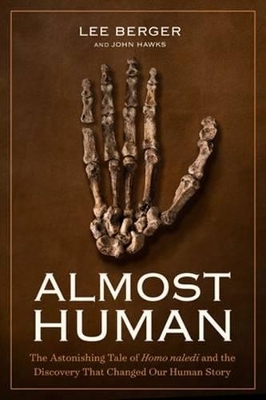
Almost Human
Seiten
2017
National Geographic Society (Verlag)
978-1-4262-1811-8 (ISBN)
National Geographic Society (Verlag)
978-1-4262-1811-8 (ISBN)
Like Donald Johanson's Lucy, this first-person narrative about an archaeological discovery is rewriting the story of human evolution. A story of defiance and determination by a controversial scientist, this is Lee Berger's own take on finding Homo naledi, an all-new species on the human family tree.
In 2013, Lee Berger, a National Geographic Explorer-in-Residence, caught wind of a cache of bones in a hard-to-reach underground cave in South Africa. He put out a call around the world for petite collaborators--men and women small and adventurous enough to be able to squeeze through 8-inch tunnels to reach a sunless cave 40 feet underground. With this team of "underground astronauts," Berger made the discovery of a lifetime: hundreds of prehistoric bones, including entire skeletons of at least 15 individuals, all perhaps two million years old. Their features combined those of known prehominids like Lucy, the famous Australopithecus, with those more human than anything ever before seen in prehistoric remains. Berger's team had discovered an all new species, and they called it Homo naledi.
In 2013, Lee Berger, a National Geographic Explorer-in-Residence, caught wind of a cache of bones in a hard-to-reach underground cave in South Africa. He put out a call around the world for petite collaborators--men and women small and adventurous enough to be able to squeeze through 8-inch tunnels to reach a sunless cave 40 feet underground. With this team of "underground astronauts," Berger made the discovery of a lifetime: hundreds of prehistoric bones, including entire skeletons of at least 15 individuals, all perhaps two million years old. Their features combined those of known prehominids like Lucy, the famous Australopithecus, with those more human than anything ever before seen in prehistoric remains. Berger's team had discovered an all new species, and they called it Homo naledi.
Lee Berger is the Research Professor in Human Origins and the Public Understanding of Science at the University of the Witwatersrand in Johannesburg, South Africa, and a National Geographic Explorer-in-Residence. He was a founder of the Palaeoanthropological Scientific Trust, today the largest nonprofit organization in Africa supporting research into human origins. The director of one of the largest paleontological projects in history, leading over 100 researchers in investigations of the Malapa site in South Africa, Berger is the author of more than 200 scholarly and popular works.
| Erscheinungsdatum | 10.05.2017 |
|---|---|
| Sprache | englisch |
| Maße | 229 x 152 mm |
| Themenwelt | Sachbuch/Ratgeber ► Geschichte / Politik ► Allgemeines / Lexika |
| Sachbuch/Ratgeber ► Natur / Technik ► Natur / Ökologie | |
| Geisteswissenschaften ► Archäologie | |
| Geschichte ► Allgemeine Geschichte ► Vor- und Frühgeschichte | |
| Geisteswissenschaften ► Geschichte ► Teilgebiete der Geschichte | |
| Naturwissenschaften ► Biologie ► Humanbiologie | |
| Naturwissenschaften ► Geowissenschaften ► Geografie / Kartografie | |
| Naturwissenschaften ► Geowissenschaften ► Mineralogie / Paläontologie | |
| Sozialwissenschaften ► Soziologie | |
| ISBN-10 | 1-4262-1811-7 / 1426218117 |
| ISBN-13 | 978-1-4262-1811-8 / 9781426218118 |
| Zustand | Neuware |
| Haben Sie eine Frage zum Produkt? |
Mehr entdecken
aus dem Bereich
aus dem Bereich
auf den Spuren der frühen Zivilisationen
Buch | Hardcover (2023)
C.H.Beck (Verlag)
CHF 27,95
Konzepte – Methoden – Theorien
Buch | Softcover (2024)
UTB (Verlag)
CHF 55,85
Was Pompeji über uns erzählt
Buch | Hardcover (2023)
Propyläen (Verlag)
CHF 44,75


